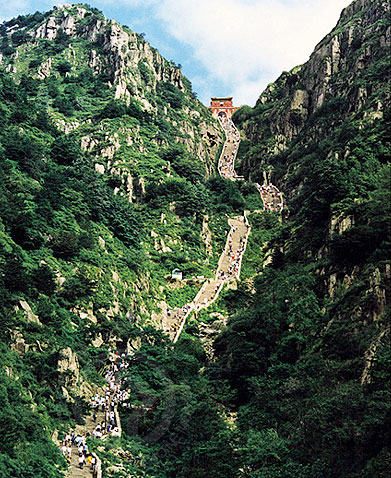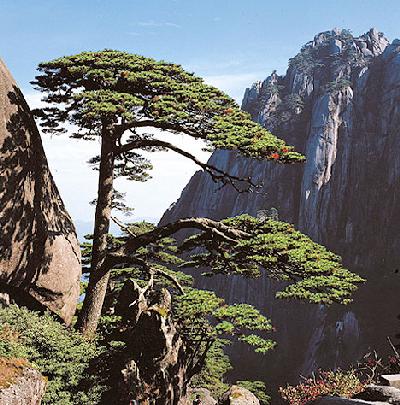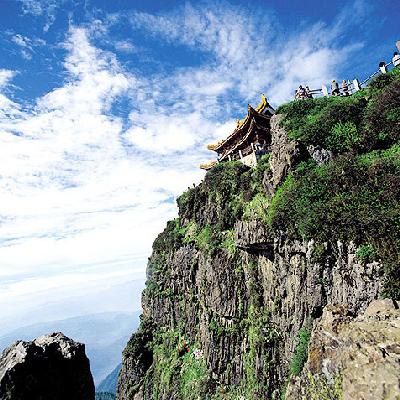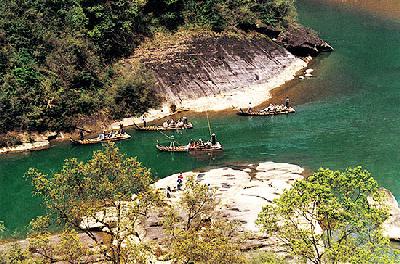

1.Overview of World Heritage Sites in China
China is now home to 14 world natural heritage sites and four cultural and natural heritage sites, both leading the world in terms of quantity.
These heritage sites effectively protected China's representative geological relics, the gorgeous mountains, forests and lakes, along with the rare and endangered animal and plant species, the National Forestry and Grassland Administration said.
The four world cultural and natural (mixed) heritage sites in China are Mount Taishan, Mount Huangshan, Mount Emei - Leshan Giant Buddha, and Mount Wuyi.
2.World Cultural and Natural Heritage Sites in China
2.1 Mount Taishan
The sacred Mount Tai ('shan' means 'mountain') was the object of an imperial cult for nearly 2,000 years, and the artistic masterpieces found there are in perfect harmony with the natural landscape. It has always been a source of inspiration for Chinese artists and scholars and symbolizes ancient Chinese civilizations and beliefs.
Long ago Taishan Mountain was called Mt. Daishan or Mt. Daizong. It was renamed Taishan Mountain during the Spring and Autumn Period. Since 1987 it has been listed as a world cultural heritage site.
Mount Taishan is in central Shandong Province and is 426 square kilometers in area; its circumference is 80 kilometers. The main peak, Jade Emperor peak, rises 1,545 meters above sea level and is north of Tai′an city. The mountain is an early birthplace of China′s ancient civilization and the area around was one of ancient China′s political, economic and cultural centers. Seventy two emperors from Xia, Shang and Zhou dynasties built temples on it. After Qin Shihuang (246-209 B.C.), emperors and scholars from various historical periods went to Mount Taishan and this accounts for the large quantity of precious cultural relics.
Mount Taishan has 72 majestic peaks, magnificent waterfalls, centuries-old pines and cypresses and fascinating rocks. There are five tour 1ist zones and two routes up the mountain-one in the east and one in the west. They meet at Zhongtian Gate and there are 6,293 steps in the nine kilometers leading to the top. The four wonders of the mountain are Sun Rises from the East, Golden Belt Along the Yellow River, Beautiful Sunset and the Sea of Clouds. Other attractive spots are the Rare Rock Dock, Fan Cliff, Aolai Peak, Black Dragon Pool, Longevity Bridge, and the Dragon Pool Waterfall.
Mount Taishan is one of China′s mountain parks and is a natural museum of history and art. Along its axis there are 1,800 stone sculptures including famous ones such as the Cared Road from the Qin Dynasty, the Buddhist Diamond Sutra in Sutra Stone Valley, the Wordless Stone Tablet and the Scripture of Taishan Mountain History carved on Tangmo Cliff. Tiankuang Hall in the Daimiao Temple, which is also on Taishan Mountain is one of the three great halls of China (the other two are the Hall of Supreme Harmony in the Forbidden City, Beijing, and Dacheng Hall in Qufu).
The 40 statues of arhat in the Thousand-Buddha Hall of the Lingyan Temple date back to the Song Dynasty and are prized for their individuality and expressiveness.

Mount Taishan
2.2 Mount Huangshan
Huangshan, known as 'the loveliest mountain of China', was acclaimed through art and literature during a good part of Chinese history (e.g. the Shanshui 'mountain and water' style of the mid-16th century). Today it holds the same fascination for visitors, poets, painters and photographers who come on pilgrimage to the site, which is renowned for its magnificent scenery made up of many granite peaks and rocks emerging out of a sea of clouds.
Mount Huangshan is in the Huangshan city area, south Anhui Province. The scenic reserve stretches 40 kilometers from north to south and 30 kilometers from east to west and takes up an area of 1,200 square kilometers.
Mount Huangshan is an important state scenic area and was listed as a UNESCO world heritage site in 1990.
The mountain has a rich history. A legend claims that Emperor Xuanyuan cultivated himself into an immortal on the mountain. Tang Xuanzong, a Taoist, renamed it Mount Huangshan in 747 and during the Ming Dynasty (1368-1644) the noted traveler and geographer Xu Xiake inspected it twice. There is a saying that "you have no wish to visit any other mountains after viewing the Five Mountains (Taishan Mountain in Shandong, Hengshan Mountain in Hunan, Huashan Mountain in Shaanxi, Hengshan Mountain in Shanxi and Songshan Mountain in Henan) and you do not even wish to visit them after you come back from a trip to Mount Huangshan."
Mount Huangshan is famous for its unique and spectacular scenery. There are 36 huge peaks, 36 minor peaks and three main peaks-Lotus Flower Peak, Tiandu Peak and Brightness Summit, which are 1,800 meters or more above sea level, Seventy seven of the peaks are over 1,000 meters above sea level apart from the spectacular rocky peaks there are strangely shaped pines, crystal clear mountain springs and seas of cloud. In the valleys there are Huangshan Pines, a tree unique to the mountain. Thousands of the pines are 100 or more years old and 31 are well known with names such as the Guest-Greeting Pine, guest-Sending off Pine and Lying Dragon Pine. There are 120 sites with spectacular rock formations. The rocks come in a variety of shapes and the big ones make rock forests while the small ones are exquisite. The peaks and dense forests in the deep valleys give rise to seas of cloud and plentiful rainfall. The spring on the mountain is clear and the water is good for drinking and bathing.
Mount Huangshan is a natural zoo and botanical garden supporting 1,452 varieties of plants and 552 types of animals. Forest coverage is as high as 56 percent.
The long history and rich culture of the mountain can be seen in the 200 surviving temples, pavilions, pagodas, zig-zag passages, ancient bridges and stone sculptures.
There are hotels and sanatoriums at the base of the mountain and at the top which can now be reached by cableway.

Guest Greeting Pine
2.3 Mount Emei Scenic Area, including Leshan Giant Buddha Scenic Area
The first Buddhist temple in China was built here in Sichuan Province in the 1st century A.D. in the beautiful surroundings of the summit Mount Emei. The addition of other temples turned the site into one of Buddhism's holiest sites. Over the centuries, the cultural treasures grew in number. The most remarkable is the Giant Buddha of Leshan, carved out of a hillside in the 8th century and looking down on the confluence of three rivers. At 71 m high, it is the largest Buddha in the world. Mount Emei is also notable for its exceptionally diverse vegetation, ranging from subtropical to subalpine pine forests. Some of the trees there are more than 1,000 years old.
Emei Mountain lies seven kilometers southwest of Emeishan City and is one of the four mountain ranges in China that Buddhists consider sacred.
The mountain stretches more than 200 kilometers from south to north. Its main peak, Wanfo Top, is 3,099 meters above sea level. Since ancient times Mount Emei has been described as "Beauty Under Heaven." Temples were built as early as the Eastern Han Dynasty (24-220) and Buddhism was introduced to the mountain during the Jin Dynasty. In the Ming and Qing dynasties there were more than 150 temples. A legend claims that the mountain was where Samantabhadra gave lectures on Buddhism and most temples house a statue of Samantabhadra. The main scenic spots on the mountain include the Baoguo Temple, Wannian Temple, Fohu Temple, Qingyin Pavilion, Heilongjiang Tunnel, Hongchun Platform, Xianfeng Temple (Jiulao Cave), Xixiang Pond and Golden Summit. These places are at different altitudes and have different climates. Temperatures at the top of mountain are 15 degrees lower than at the foot. The mountain, which supports more than 3,000 varieties of plants and many animals, is an important scenic area.
Baoguo Temple sits at the foot of the mountain at the entrance and exit of the mountain area. The temple was built during the reign of Ming Emperor Wanli (1573-1620). About 15 kilometers from the Baoguo Temple is Wannian Temple, one of the main temples in the mountain area. Wannian Temple, or the Temple of Samantabhadra as it was known before the Ming Dynasty, was built during the reign of Emperor Long′an of the Eastern Jin Dynasty (397-401). It has no beams and houses a bronze statue of Buddha Samantabhadra mounted on a six-toothed white elephant cast in 980, the fifth year of the Northern Song Dynasty. The statue is 7.3 meters high and weighs 62 tons.
At the Golden Summit, the Pinnacle of the mountain area 3,065 meters above sea level, is Puguang hall or Temple. It was constructed during the Eastern Han Dynasty and has been rebuilt several times after being struck by lightning. The Golden Summit is an ideal place to view the sunrise, the sea of clouds, the "Buddhist lights" and "sacred Lamps." Emei Mountain is a well known natural museum with more than 3,000 specimens of plants and 2,000 types of animals including groups of monkeys that appear on the mountain roads and fascinate the tourists.
The Giant Buddha on the east bank of Minjiang River in Leshan City, Sichuan Province, rests his feet where three rivers-the Minjiang, Qingyi and Dadu-join. The Buddha faces Emei Mountain across the river and at its back is the western slope of Lingyun Mountain. Standing at 70.7 meters with shoulders 24 meters wide it is an impressive sight. A water drainage system reduces erosion by rain and slows weathering.
The statue was begun in 713, the first year of the reign of Tang Emperor Xuanzong, and completed in 803, the 19th year of the reign of the Tang Emperor Dezhong. To the right of the statue a plank road with nine turns was built and it is now famous as the nine-turn plank road; it goes from the bottom to the top. It is included in the UNESCO world heritage list in 1996.

Mount Emei
2.3Mount Wuyi
Mount Wuyi is the most outstanding area for biodiversity conservation in south-east China and a refuge for a large number of ancient, relict species, many of them endemic to China. The serene beauty of the dramatic gorges of the Nine Bend River, with its numerous temples and monasteries, many now in ruins, provided the setting for the development and spread of neo-Confucianism, which has been influential in the cultures of East Asia since the 11th century. In the 1st century B.C. a large administrative capital was built at nearby Chengcun by the Han dynasty rulers. Its massive walls enclose an archaeological site of great significance.
The 60-square-kilometer Wuyi Mountain is about 15 kilometers south of Wuyishan City in Fujian Province.
It is a famous scenic area surrounded by valleys and isolated from other mountains. Places of interest include the Nine-Turning Stream and 36 peaks and 99 rocks. Nine-Turning Stream starts from the Sanbao Mountain and flows through Xingcun Village before entering the Mount Wuyi area and it is a wonderful experience to float down the stream from the village on a bamboo raft. Wannian Palace in Chongyou, Chaiyang Academy and Hongqiao Bridge are historical sites and other places of scenic interest are Dawang Peak, Yunu Peak, Jiesheng Peak, Lesser Peach Garden and Skyline. There are also many rare plants and animals as well as the Wuyi Mountain Museum of Nature. In 1988 it was listed as one of the world′s biosphere protection areas.

Mount Wuyi
From:
1.Flying over world cultural and natural heritage sites in China (www.gov.cn)
Source: english.www.gov.cn/news/videos/202206/17/content_WS62abf788c6d02e533532c4f3.html
2.World Heritage in China-Institute of Geographic Sciences and Natural Resources Research <http://english.igsnrr.cas.cn/eocg/whic/>
Source: english.igsnrr.cas.cn/eocg/whic/
3.世界遗产中心 - (unesco.org) <https://whc.unesco.org/zh/list/?cid=31&lother=zh&cid=31&lother=zh&&&mode=list>
Source: <https://whc.unesco.org/zh/list/?cid=31&lother=zh&cid=31&lother=zh&&mode=list>
Edited by Lianying Bao